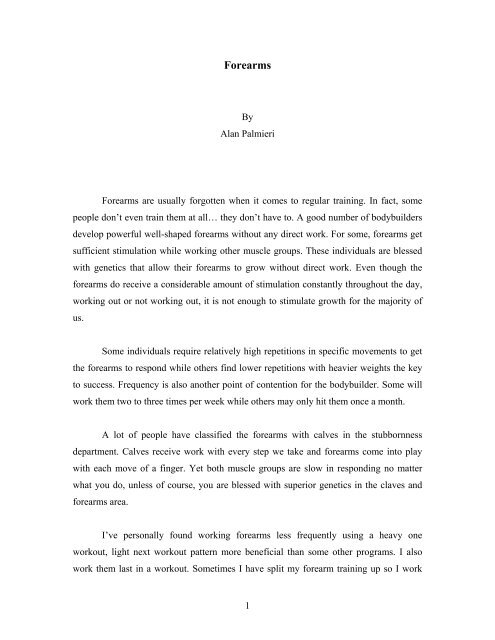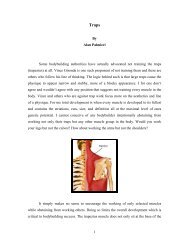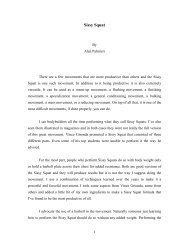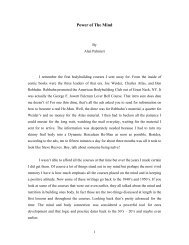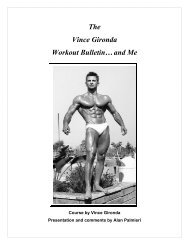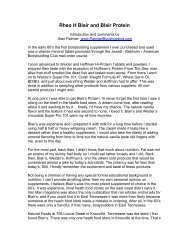Forearms - Palmieribodybuilding.com
Forearms - Palmieribodybuilding.com
Forearms - Palmieribodybuilding.com
Create successful ePaper yourself
Turn your PDF publications into a flip-book with our unique Google optimized e-Paper software.
<strong>Forearms</strong><br />
By<br />
Alan Palmieri<br />
<strong>Forearms</strong> are usually forgotten when it <strong>com</strong>es to regular training. In fact, some<br />
people don’t even train them at all… they don’t have to. A good number of bodybuilders<br />
develop powerful well-shaped forearms without any direct work. For some, forearms get<br />
sufficient stimulation while working other muscle groups. These individuals are blessed<br />
with genetics that allow their forearms to grow without direct work. Even though the<br />
forearms do receive a considerable amount of stimulation constantly throughout the day,<br />
working out or not working out, it is not enough to stimulate growth for the majority of<br />
us.<br />
Some individuals require relatively high repetitions in specific movements to get<br />
the forearms to respond while others find lower repetitions with heavier weights the key<br />
to success. Frequency is also another point of contention for the bodybuilder. Some will<br />
work them two to three times per week while others may only hit them once a month.<br />
A lot of people have classified the forearms with calves in the stubbornness<br />
department. Calves receive work with every step we take and forearms <strong>com</strong>e into play<br />
with each move of a finger. Yet both muscle groups are slow in responding no matter<br />
what you do, unless of course, you are blessed with superior genetics in the claves and<br />
forearms area.<br />
I’ve personally found working forearms less frequently using a heavy one<br />
workout, light next workout pattern more beneficial than some other programs. I also<br />
work them last in a workout. Sometimes I have split my forearm training up so I work<br />
1
with wrist curling movement’s one day and reverse wrist curling movements the next<br />
day. I don’t like doing this however, as I prefer to train the entire forearm in one session.<br />
One thing I never do is work the forearms before working biceps, triceps, or back. As<br />
mentioned, I work them at the end of a workout. If I were to work forearms and then<br />
back, I couldn’t get a good back workout because just holding on to the bars in back<br />
movements fatigues the forearms.<br />
I’ve found working the forearms every week provides a lot of shape but does not<br />
add much size. Remember my first precaution statement in all training matters. People<br />
are all different, what works for one most likely won’t work for someone else. Find that<br />
which works best for you. All I can do is relate what has and does work for me and for<br />
many others.<br />
I’ve found the following routine for adding size to my forearms one of the most<br />
productive.<br />
Workout 1.<br />
EZ Bar Reverse Curls 4 x 6 – 8 / 10 - 12<br />
Barbell Palm Up Wrist Curls 4 x 6 – 8 / 10 – 12<br />
Workout 2.<br />
Flat Bench Reverse Writs Curls 3 x 6 –8 / 10 - 12<br />
Dumbbell Palm Up Wrist Curls 3 x 6 – 8 / 10 - 12<br />
Workout 3.<br />
Preacher Reverse Curls 4 x 6 – 8 / 10 - 12<br />
Standing Barbell Behind Back Wrist Curls 4 x 6 – 8 / 10 - 12<br />
Workout 4.<br />
EZ Bar Wrist Curls 4 x 6 – 8 / 10 - 12<br />
Reverse Dumbbell Wrist Curls 4 x 6 – 8 / 10 – 12<br />
2
EZ Bar Wrist Curl Starting Position<br />
EZ Bar Wrist Curl Finish Position<br />
Performing Wrist Curls with an EZ Curl Bar seems to place an entirely different<br />
feel <strong>com</strong>pared to the straight bar. I seem to have a much more difficult time in<br />
contracting the forearms in the finish position. Even though the hands are in a more<br />
natural position <strong>com</strong>pared to using a straight bar, they seem to work harder and I am<br />
unable to use as much weight.<br />
When trying to add mass to forearms, I would usually keep the number of sets to<br />
around 3 to 4 and would reduce the repetitions down to around 6 to 8. This worked great<br />
for me. One workout I would use heavy weights for sets consisting of 6 to 8 repetitions<br />
while the next workout I would follow the same number of sets only I would use a lighter<br />
weight for 10 to 12 repetitions.<br />
3
I would work forearms twice a week although I did have a great deal of success<br />
when I worked them extremely hard only once per week. Here again experiment a little<br />
and see what works better for you.<br />
Using the workout outline above, each session use a different workout. For<br />
example, if you are going to work forearms twice a week, use workout 1 the first forearm<br />
session of the week using heavy weights and workout 2 the second session of the week<br />
using lighter weights. The next week use workout 3 for the first session again with<br />
heavier weights and workout 4 for the next one with lighter weights. For week three start<br />
all over again with workout 1. This cycle however, rotate and use heavy weights on<br />
movements you used light weights on last time and visa-versa. In other words, in a period<br />
of two weeks you would only perform each listed workout one time. If you decide to<br />
work forearms only once per week you would not repeat a listed workout until your fifth<br />
week. You should still alternate between heavy and light workouts.<br />
Ever so often, when my energy level was high and I had time, I would perform<br />
wrist curls and reverse wrist curls with a weight that would allow me to perform two sets<br />
of as many reps as I could, always with a hundred reps as the goal. Another time I might<br />
super-set wrist and reverse wrist curls for two sets of fifty reps. In either case, talk about<br />
a pump; forget about even eating after these sessions. It rendered my hands and fingers<br />
useless. I didn’t use these often and I believe the fact I did not on a regular basis but<br />
infrequently was responsible for exceptional growth. Done on a regular basis, overwork<br />
would have caused muscle loss.<br />
© Copyright 2005 Alan Palmieri<br />
4


